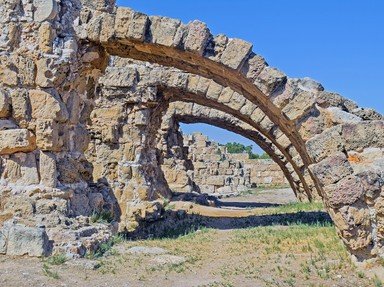Quiz Answer Key and Fun Facts
1. Quite often shrouded in mist, seeing Stonehenge for the first time always affects people profoundly. Just the sound of the name evokes a sense of awe and sends spine tingling shivers to the depths of our very being. Where did it come from, and why is it there, are just some of the questions which people ask.
To reach these answers, you need to take a step back in time, long, long ago, to the Neolithic period. So, what were the two types of stone used in the making of Stonehenge?
2. Stone communities built many centuries ago still stand strong today, telling us about the people of yesteryear, their lives and how they survived through hardship without the modern amenities of today.
One such place is Skara Brae, a Neolithic settlement which stands above a remote sandy bay in the wilds of Scotland. On which group of islands can it be located?
3. As fog drifts down from the rugged Cumbrian mountainside, it gently envelopes one of the most atmospheric and dramatically placed stone circles in England. It is situated in a natural amphitheatre overlooked by the impressive hills of Skiddaw, Blencathra and Clough Head.
As one of approximately 1,300 stone circles in the United Kingdom, what is the name of this particular national treasure?
4. Inside a remote graveyard alongside the tranquil Lower Lough Erne in Northern Ireland stand two unique stone figures, believed to be Celtic idols. One is called the Boa Island figure, and the other the Lustymore figure.
The larger of the statues called the Boa Island figure has the face of a female on one side, and a face of a man on the other. What type of figure is this?
5. Many standing stones have got ancient legends and rituals attached to them which give us an insight in to who used to live in the area. None more so than the stone with the hole which is situated on open moorland in the heart of Cornwall, just north of Penzance.
Age old myths passed down through the centuries provide us with a glimpse through the window into another world at which of these landmarks shown in the image?
6. Wales, land of my fathers. Wales, land of poets and singers, and people of stature. Wales, land of enchanting voices, brave warriors and green valleys steeped in the romance of yesteryear.
In one of these green valleys, overlooking the winding Nevern River in Pembrokeshire, proudly stands Pentre Ifan. What is another name given to this type of megalithic burial chamber?
7. In amongst a wooded clearing just to the east of Inverness in Scotland is a circular mound of stones. It is only when you study the area more closely that you see other stone structures, one with distinctive cup and ring markings.
These man made memorials erected in the Bronze Age are called the Balnuaran of Clava. By what alternative name is a man-made mound of stones of this nature known as?
8. A well preserved stone chambered tomb called Bryn Celli Ddu can be located in the far north-west of Wales, on the island of Anglesey. When visitors leave for the day, peace envelops the surrounding green fields, trees and hedgerows, with only the company of sheep and cattle remaining.
The sing-song language of the Welsh softly speaks the name Bryn Celli Ddu, but how can this be translated into English?
9. In 1781, a Scots gravedigger accidently dug up a stone slab in the churchyard at Dyke Church, a small sheltered parish in Moray, Scotland. Little did he know at the time that he had excavated an important piece of history, nowadays called Rodney's Stone.
With unusual markings of an ancient cross on one side and fish monsters on the back, which tribe of people were responsible for making this intricately carved stone?
10. The stone slab on this image looks insignificant, with lines scored deeply into its side, but it is living proof that our Irish ascendants used this symbol as an early form of writing.
Beith-Luis-Nin, similar to its Greek counterpart alpha, beta, gamma, is the alternative name for which early form of alphabet scored onto stones?
Source: Author
Plodd
This quiz was reviewed by FunTrivia editor
stedman before going online.
Any errors found in FunTrivia content are routinely corrected through our feedback system.

